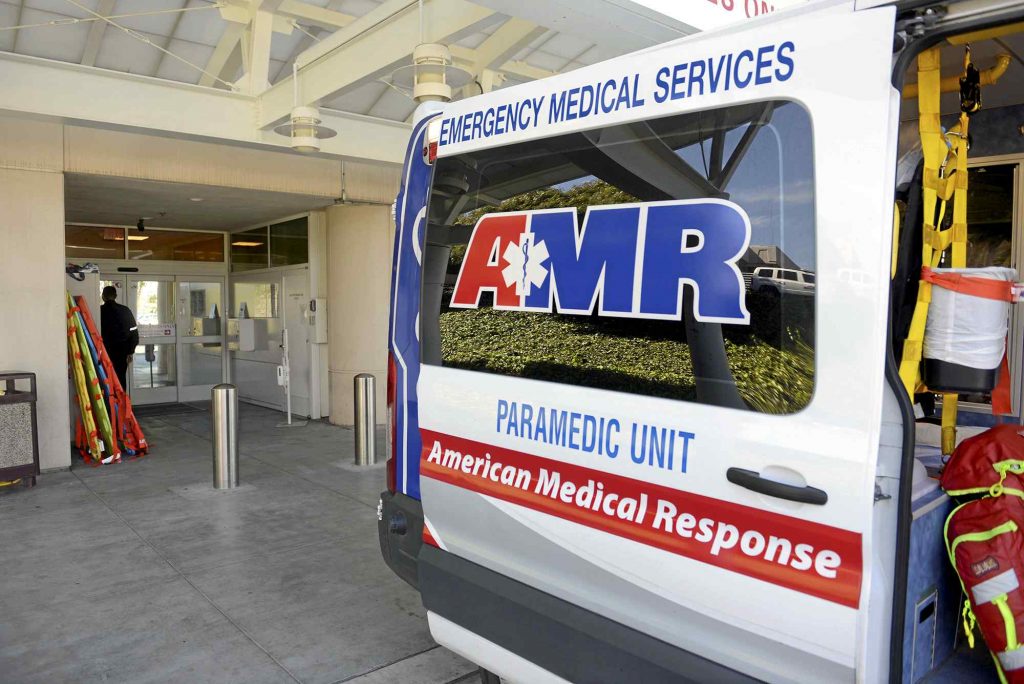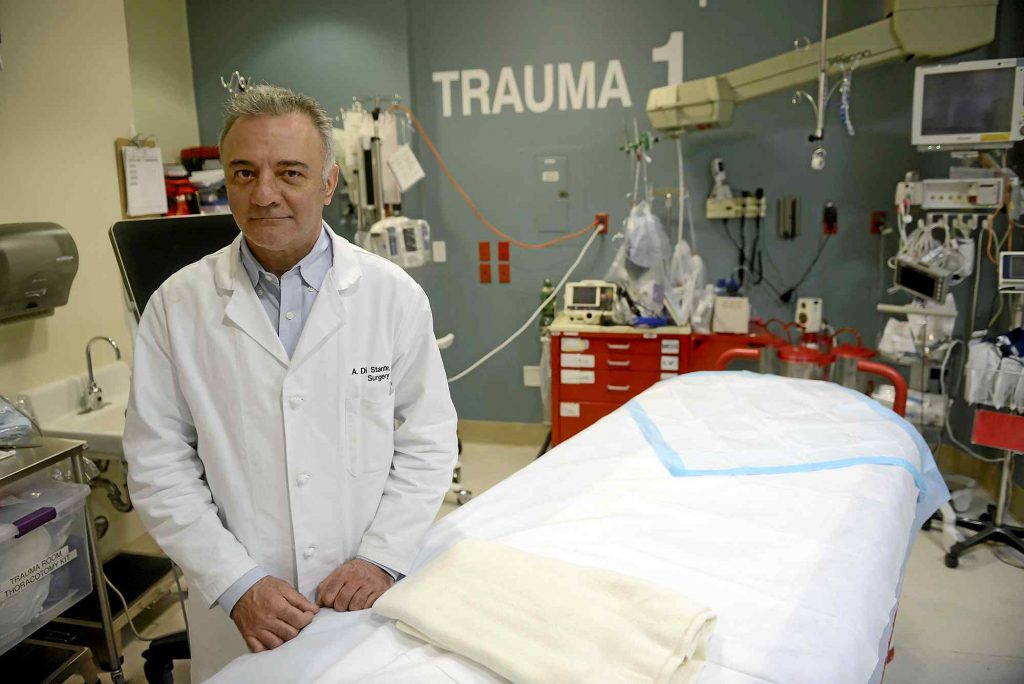Saving Lives: Natividad’s Trauma Center Program Enters Fourth Year
- March 31, 2018
- Monterey Herald
By Jim Johnson
Ivan Valdez Sanchez was driving his two younger sisters to go shopping at the Del Monte Center as a reward for getting good grades on a wet November afternoon when the unthinkable happened.
The 20-year-old’s Ford Mustang hydro-planed on Monterey-Salinas Highway near Tarpy’s and skidded sideways into oncoming traffic where it was t-boned by another vehicle at an estimated 45 miles per hour. Sanchez’s sisters, 12-year-old Alexa and 8-year-old Paola, absorbed the brunt of the collision on the passenger side of the car, which ended up slamming into a tree on the side of the roadway. All three ended up trapped in the car, with Alexa having sustained a lacerated liver and internal bleeding, and Paola suffering a broken neck and arm.
After the trio were freed from the car, which Ivan said looked like a “fortune cookie,” both Alexa and Paola were sped by ambulance to Natividad Medical Center, with Ivan following behind with bruised ribs and lungs from the impact.
Auto accidents have been the most common cause of traumatic injury treated at the county-owned hospital’s trauma center, which marked the third anniversary of its Level II certification in January, representing about 40 percent of the 1,400-1,500 trauma cases it sees each year.
By comparison, about 20 percent of all traumatic injuries at Natividad are caused by falls, and 15 percent are from gunshots or stabbings, while motorcycle and bicycle accidents, pedestrian injuries, and assaults cover the remaining 25 percent of trauma cases at the hospital.
Since Natividad emerged from a competition with Salinas Valley Medical Center several years ago for the right to establish the Monterey Bay’s first Level II trauma center program and the only one of its kind between Santa Clara and Santa Barbara counties, the county-owned hospital has continually invested in everything from physicians, medical staff and support staff to capital investments in the facility and equipment, and in expanded training and education programs.
All of it has been aimed at improving the program’s capacity for saving patients who might otherwise not have survived if they had to be flown as before to a Bay Area trauma center instead of being treated quicker at Natividad.
Indeed, a local trauma center program can improve survival rates as much as 20-25 percent, according to Natividad Trauma Program Medical Director Dr. Alex Di Stante.
Natividad Trauma Program Manager Julie Ramirez said “caring for trauma patients has been both a challenge and a blessing.”
“We are constantly striving to improve all aspects of providing care to injured patients, which is what the mission is all about,” Ramirez said. “Over the past three years, we have seen the program mature and have had many great saves of patients who would not have done well without us.
“Every year at this time serves as a reminder of where we were before and how far we’ve come.”
Ordinarily, children aged 14 and under with serious injuries are still flown to a Bay Area pediatric trauma center, but Alexa and Paola couldn’t be flown out due to the inclement weather. So the Natividad trauma team went into action, sending Alexa immediately into “damage control” surgery with Di Stante performing the procedure, and working to stabilize Paola with a neck brace and halo.
Eventually, both were flown to Stanford Children’s Hospital.
Since the program’s inception, Natividad has built up its trauma team led by Di Stante and Ramirez to include seven trauma surgeons, not including affiliated neurosurgeons, nine trauma nurse practitioners, and seven trauma program staff, along with 17 emergency medicine physicians trained in trauma and 60 emergency department nurses with trauma core course training.
In addition, the hospital has hired other nursing, technical and support staff in response to increased patient volume throughout the hospital.
At the same time, the hospital has completed an emergency department rapid medical evaluation remodel project, which provides enhanced triage nurse services to streamline patient flow, timely access to an emergency physician, and quicker overall patient processing.
The hospital is also in the midst of a radiology modernization project designed to accommodate new MRI, CT, angiography, and nuclear medicine equipment.
Meanwhile, the designated teaching hospital offers advanced trauma life support training through the program to physicians, physician assistants and nurse practitioners from all over the nation, and even from a few foreign countries such as New Zealand and the Netherlands. To date, more than 55 medical staff have been through the training at Natividad.
Natividad chief medical officer Dr. Craig Walls said the entire hospital has benefited from the trauma program, which he credited to the “halo effect” of a trauma designation.
“I liken this to a rising tide lifting all boats,” Walls said. “It elevates the whole hospital. There have been a great number of improvements.”
Those include new service lines such as neurosurgery and interventional radiology that the hospital didn’t offer before, a major increase in medical staff training associated with ongoing program requirements, and easier recruitment and retention of staff due to the trauma program attracting higher acuity, sicker patients.
Walls said the hospital is already stretched to its limits and is looking to expand, with a new emergency department in the early planning stages that would ultimately house the trauma center program.
Going forward, Walls said the hospital staff will need to stay on its toes in the future, too, because of the rapidly changing field of trauma care.
“It’s a very fast moving field, in terms of technology and medicine and methods,” he said. “Keeping up with the changes is exhilarating, challenging. It’s a great area to be involved in.”
Ramirez said the trauma program will focus its efforts in the future on improving rapid transport of patients to the hospital by working with first responders and other area hospitals, and more effectively identifying high-risk trauma patient populations.
After months of recovery and physical therapy, Alexa and Paola have recovered to the point where Ivan said “it’s like the accident never happened.” The girls, he said, are running around their Marina home like they did before the accident and have returned to school at Marshall Elementary in Seaside.
Recently, the family made a visit to Natividad and Di Stante, who Ivan said was amazed the girls had recovered so quickly.
The girls’ mother, Leticia, said Stanford medical staff told her that without Natividad and Di Stante’s surgical work that Alexa would not have survived.
“Thank goodness they’re still with us,” Ivan said. “Another 15 minutes and she wouldn’t have made it. He (Di Stante) saved her life.”


